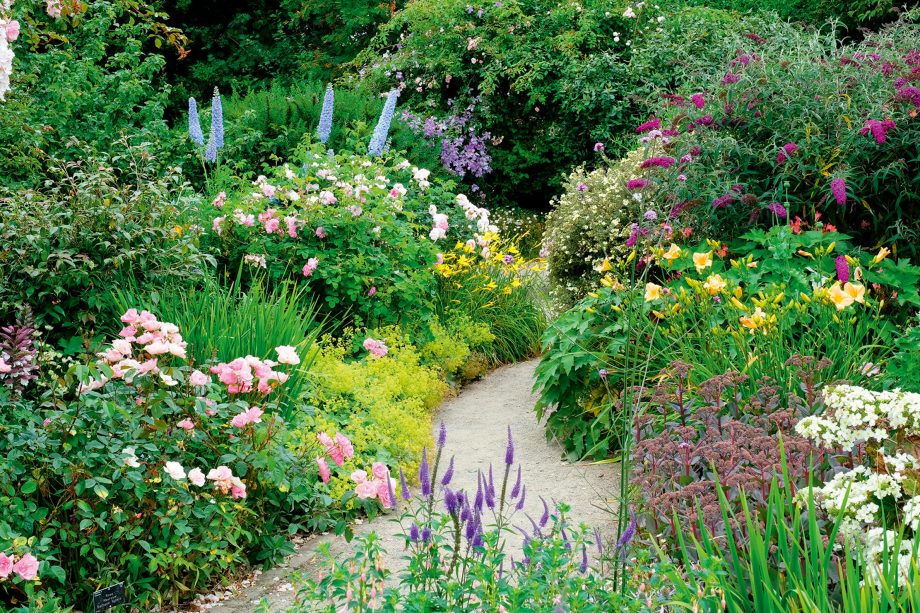Some gardeners may scoff at the idea of planting a shrubbery, but not John Hoyland.
Over the past few decades, there have been regular declarations in the gardening media that shrubs are making a big comeback. It hasn’t happened yet. Gardens generally are getting smaller — too small for large shrubs — and our impatience for quick results is better served by herbaceous perennials and bedding plants.
This state of affairs is compounded by the lack of experience — and, worse, a lack of interest — in growing shrubs among some garden designers. I know several designers who can name dozens of varieties of kniphofias and hardy geraniums and many forms of miscanthus, but can barely identify a viburnum or an osmanthus. Their focus is on creating plant communities of herbaceous perennials and grasses with an occasional evergreen shrub thrown in to provide ‘a bit of structure’.
Memories of dingy shrubberies, hangovers from Edwardian gardens, usually dominated by overgrown rhododendrons and laurels, often planted as screening and where the plants merge into an amorphous mass, may have blinded us to the beauty of shrubs.
Any flowers that struggled to appear in these places had faded by early summer and the soil the plants grew in was compacted, dry and lifeless. Their only benefit was that shrubberies provided hiding places for children who could sneak into them to make dens and imagine adventures away from the disapproving gaze of grown-ups.
If we dislodge the filter of those memories and take a fresh and interested look once again at the idea of a collection of shrubs, the possibilities are immensely appealing. This is why I am happily preparing to plant a shrubbery, despite the puzzled reaction of a few friends, which could have been perfectly captured by an H. M. Bateman cartoon: The Man Who Decided to Plant a Shrubbery.
“Lilacs are currently about as fashionable as shrubberies, but here they looked stupendous”
The plants in my shrubbery will be distinct from each other, sitting comfortably with their neighbours, but not being swallowed by them; each will have a moment in the limelight, but without eclipsing the other plants. And, unlike those areas of the garden planted with perennials, which are reduced to bare earth during the winter, here there will be year-round interest. Seed-heads and grasses left to stand over winter do have a charm, but they cannot compete with the spectacle of the weak winter sun glancing off the polished leaves of evergreens or the drama of the backlit tracery of the branches of deciduous shrubs.
At the moment, I am preparing the ground by removing weeds and layering on compost. A well-prepared soil will help give my shrubs resilience. The shrubs themselves will be a mixture of common-or-garden varieties combined with a few rarities. Among the taller shrubs will be evergreen myrtle and deciduous Cornus ‘Ormonde’, a tall, spreading hybrid dogwood with large white bracts.
Rosa moyesii will provide bright hips in the autumn and scented scarlet flowers in the spring. Included in the evergreen elements will be the reliable workhorse of Choisya ternata and, creating a lower layer, the slightly more tender Pittosporum tobira. Both have a compact, domed shape and perfumed flowers, as does the highly scented Elaeagnus ‘Quicksilver’, which will add a more relaxed, even gangly, habit.
The seeds of the idea for a new shrubbery sprang from seeing a collection of lilacs planted by a friend in an area of rough grass. Lilacs are currently about as fashionable as shrubberies, but here they looked stupendous, the space between the plants allowing the light to filter through, giving glimpses of the woodland beyond. There will, therefore, be lilac — mainly forms of the common lilac — but I will add a plant of Syringa microphylla, which I have elsewhere in the garden. It has small leaves, a compact habit and is smothered in rosy-pink flowers in May.
I would like to add the pale-blue flowers of Syringa ‘Firmament’, the bluest of all lilacs, but it is hard to come by and, if I can find a nursery that grows it, I know that the plants will be too small for a gardener in a hurry. I reckon that it will take five years for my shrubbery to become as established as it is in my mind’s eye, so I want decent-sized shrubs. For this reason, I am not going to be too prescriptive about the cultivars that I finally plant and I intend to tailor my choice to specimens that are large enough and that nurseries have available. In a few years’ time, with luck, I will have a mature-looking shrubbery. And I might well invite some of my garden-designer friends to come and admire it.
John Hoyland is gardens adviser at Glyndebourne, East Sussex

The 12 best flowering shrubs to plant for year-round colour in your garden
For year-round structure, intrinsic beauty and sheer usefulness, shrubs–the original low-maintenance plant–are hard to beat. Charles Quest-Ritson applauds their return

The 10 best shrubs for your garden, by the legendary gardener who’s dedicated his life to them
The revered gardener Peter Catt — one of a tiny number of people to have won the RHS’s top accolade

Hydrangeas: Varied, colourful and lovingly tended to by the wizard of White House Farm
Mark Griffiths extols the beauties of this shrub, from its 18th-century beginnings to its revival in the hands of hydrangea

How to grow the bladdernut, a delightful shrub with the heavenly scent of vanilla custard
An email from a friend spurs Mark Griffiths to take a look at the curiously-named bladdernut, a vigorous and easily-grown




